Music for the Divine Office
-
It seems that most music resources these days are aimed at improving the Holy Sacrifice of the Mass. It is quite right that they are since the Sunday Mass is the main liturgical encounter that the laity will have. However, there has also been a resurgence in participation in the Divine Office (Liturgy of the Hours). In particular, Vespers is starting to become a popular alternative to having Mass for various functions such as school presentation nights or diocesan gatherings for various causes.
I am developing a collection of resources for the Divine Office in English. I understand that there are some difficulties because different translations and arrangements are used between the US and the UK/Wales/Australia editions, but I intend to share my work here, and I would hope that others who are similarly minded would share their work too. -
Attached is my English adaption of the antiphon for the Nunc Dimittis. There are competing schools of thought on how chant should be arranged. For this antiphon I have opted to preserve as much of the original latin melody as possible so as to make transitions between Latin and English chant as easy as possible.
I don't have any engraving softward, so I mostly create images using nothing more than Microsoft Paint.
I would welcome any comments and constructive criticisms.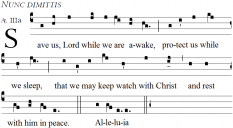
 Nunc Dimittis English Version 1.png1000 x 550 - 35K
Nunc Dimittis English Version 1.png1000 x 550 - 35K -
Is that using the ICEL translation? I don't think it is...
-
It is the translation used for UK/Wales/Australia - it is probably different to the American translation.
I am also basing the antiphons rather heavily on the office psalm tones so that they are easily picked up. -
Four Antiphons.
They are for the Psalmody at Compline on Thursday, Friday and Saturday. They are my own melodies, based around Office Psalm Tone II. The main idea is that the Antiphons are in the same Tone as the Psalm and follow a similar basic pattern to the Psalm Tone.
I'll use other Psalm tones for the other antiphons, but the psalms for Thurs-Sat night compline seemed to best suit Tone II. I have set the Nunc Dimittis to Tone III, based on Liber Usualis (via the Parish Book of Psalms 2nd Ed.)
I'd welcome any constructive criticism and/or feedback.
These are for a student retreat to be held next weekend.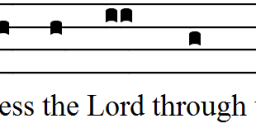
 Antiphon Bless the Lord through the night.png622 x 155 - 8K
Antiphon Bless the Lord through the night.png622 x 155 - 8K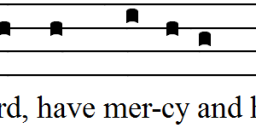
 Antiphon Lord have mercy and hear me.png624 x 150 - 8K
Antiphon Lord have mercy and hear me.png624 x 150 - 8K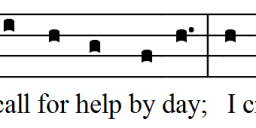
 Antiphon Lord my God I call for help by day I cry at night before you.png1070 x 170 - 14K
Antiphon Lord my God I call for help by day I cry at night before you.png1070 x 170 - 14K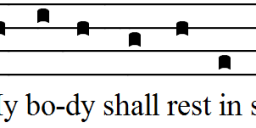
 Antiphon My Body Shall Rest in Safety.png623 x 151 - 9KThanked by 1bonniebede
Antiphon My Body Shall Rest in Safety.png623 x 151 - 9KThanked by 1bonniebede -
As far as I am concerned most of the important work for the english language divine office with antiphons has already been done by Ormonde Platter. It is specifically for the Benedictine office, however I beleive most of the antiphons in it also exist and match the current secular Liturgy of the Hours "Antiphonale Romanum II". I'll leave it for someone else to compare them more closely, as I prefer the Benedictine for the novus ordo because it is more traditional format and more interesting.
http://www.oplater.net/AM--seasons.pdf
What we really need now is an english hymnal matching the Liber Hymnarius and pointing of the 150 revised grail psalms and ICEL canticles. I guess I should post a .pdf of my hymnal, it doesnt match the liber hymarnius precisely but it is close.
Frogman Noel Jones has most of the Revised Grail Psalms pointed according to "anglican chant" but I found that the pointing applied just fine for Gregorian chant too. He can post his work sometime (that is unless he wants to sell it.)Thanked by 1Ben Dunlap -
What we really need now is an english hymnal matching the Liber Hymnarius and pointing of the 150 revised grail psalms and ICEL canticles. I guess I should post a .pdf of my hymnal, it doesnt match the liber hymarnius precisely but it is close.
I'm being patient with the hymns, as the new USCCB version of the Liturgy of the Hours is supposed to include metrical English translations of the Latin LotH hymns... I only hope they retain the same meter as in the Latin, to allow for what you describe. -
Ok, getting that done goes back on the TODO list, thanks, Chris!
-
hartleymartin, please consider learning a bit about Gregorio and GABC. This will make it easier for other people to help you in your work or use your materials.
http://illuminarepublications.com/gregorio/Thanked by 1Ben -
I'll look into it. My work has always just been for my own uses so I've always used what was easiest and most immediately accessable to me.
-
hartleymartin, two small suggestions for your Nunc Dimittis antiphon:
* For "Lord while we are awake", how about shifting the melody back a beat, as it were:
- Do-Re for "Lord"
- Do for "while"
- Do-Ti for "we"
- La for "are"
- Ti then La-Sol for a-wake
This gives more weight to the nouns "Lord" and "we"
* I would try 'we sleep' as La-Do for 'we' and then just the lengthened Ti for 'sleep'. The descending 1,1-2 on a one-syllable English word feels awkward to me (I'm sure there's a more technical way to describe this but I don't know what it is)
-
Ben - All very good suggestions, I'll try the changes soon.
My aim for this antiphon was to preserve as much of the original melody of the Latin, thereby making it easier for people to transition between English and Latin. In my planned in-house booket (Order of Sung Compline) I will eventually have the entire setting in parralell English and Latin.
Looking at the antiphon, I was thinking of having a second punctum on Lord or an emphasema to lengthen it and to remove the Do from "are" and having only a Ti. I was also thinking that a lengthening may be required on the La of "a-wake" and Do of "sleep".
The trouble is that there are so many possible ways of doing this! -
Hartley, I respectfully disagree with Ben. I very much appreciate how your setting of the English text reflects the structure of the Latin text, which is all about the petition and the parallelism:
Salva nos, * Dómine, vigilántes, custódi nos dormiéntes;
ut vigilémus cum Christo, et requiescámus in pace.
Plus the rhythm of 'salva nos/custodi nos' de-accents the 'nos' (us).
And I really like the declining do-ti on 'sleep'! (I know it's a feature of mode IIIa, but that doesn't make me like it less.)
It is too bad that the translation is clunky. As a convert from Anglicanism who chanted many Vespers in the BCP English and also in Latin (when you're the only person in the area who chants and reads the Liber like its one's native language, well...), I am partial to the Anglican translation:
Guide us waking, O Lord, and guard us sleeping;
That awake we may watch with Christ, and asleep we may rest in peace.
(although 'guide us' isn't exactly right for 'salva nos')
Ah, for the long-awaited new translation of the LOTH. -
When it comes I will be ready to fly into setting the new antiphons to music.
-
When it comes I will be ready to fly into setting the new antiphons to music.
Before that happens, just a thought I'd like to share.
While I find nothing wrong with your setting of the Thurs-Sat antiphons above, I would kindly suggest you look into the modes of original Latin antiphons before choosing a mode based on the Psalm. While keeping the antiphons all in the same mode and mostly based on the same formula is certainly helpful in a retreat situation where people may be experiencing the sung Office for the first time, you will find that the original Latin antiphons are sometimes surprising in the mode they present for certain Psalms.
In view of continuity with tradition, I would be hesitant to think to myself, "Gee, in what mode would I like to chant this Psalm?" and then compose my antiphon in that mode. It would be better, I think, to look to the mode of the antiphon given in the Antiphonale or one referenced in the Ordo Cantus Officii and base it from there.
I also like your setting of Salva Nos as it is. I would add that the most recent Solesmes edition of the Antiphonale Monasticum has restored the reciting tone of mode III to 'ti' instead of 'do'... the strong melodic pull towards 'do' being something that may have snuck in during the Renaissance. In any case, I've attached this version, along with my own adaptation to the US Liturgy of Hours antiphon.
 Salva nos, Domine.png5100 x 2820 - 148K
Salva nos, Domine.png5100 x 2820 - 148K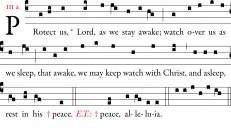
 Salva nos, Domine (English).png5100 x 2820 - 156KThanked by 1hartleymartin
Salva nos, Domine (English).png5100 x 2820 - 156KThanked by 1hartleymartin -
Patricia, can you go into more detail about how Hartley's original setting retains the structure of the Latin?
I like your point about de-emphasizing nos/we. Following this line of thought it's interesting to note that Salva and Domine are the only ornamented words in the opening phrase of the Latin original.
It would be tough to imitate that pattern completely in this translation, but something like the attached approaches it.
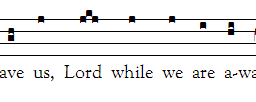
 save_us.png385 x 102 - 4K
save_us.png385 x 102 - 4K -
Ben,
Assuming we're going to use the Liber version with reciting tone on do instead of ti - (which seems to be a reasonable choice if people are already familiar with that version), it seems to me that for the first few notes, so-la on "save" followed by "us" does not evoke mode III so much as say, mode VIII - again at least to me. However, the case you make for ornamenting "save" is well and good. Perhaps then, you could make a three note scandicus on "save" on so-la-do (or so-la-ti if using the "new" "old" mode III).
I also think there's something very "mode III"-ish about having the do-ti clivis somewhere (matters less to me where, as it's on a weak syllable in the Latin) in that opening phrase rather than breaking it up over two words. Again, I can claim no formal study with a master on any of this, but what I say just comes from my (limited) experience.
I know there are many who may disagree with me, but I still find it is unnecessary that so many English adaptations of chant remove short two or three note melismas that may fall on weak syllables - often at the expense of modal characteristics. These short ornamentations on weak or less-important syllables don't seem to bother anybody when they occur in Latin. I posit that their presence in English adaptations bothers people who may have a good understanding of Latin, but still happen to think in English. (Not that my mastery of Latin is strong enough to think in it, per se...)
In any case, if one is in fact an English speaker, one should be able to sing it with attention to the proper declamation of the words no matter what the melody throws at you. -
SkirpR, I definitely see what you mean about mode VIII at the beginning, especially considering the most recent edition of the Latin antiphon (I don't hear much difference in the Sol-La-Do Salva in the Liber -- do you?)
I'm also starting to understand about the Do-Ti clivis, although one might argue that "we are" in this English translation might as well be one word (since it corresponds to no distinct words in the Latin) and thus could be sung as a clivis. That might be stretching things a bit, though! -
Is there any online document that I can have access to which will help me determine which psalm tones are traditionally associated with each psalm? I need to get cracking on this because I have 5 days to have the retreat liturgy book ready and I cannot afford to be changing psalm tones or rushing composition of antiphons!
-
My point actually is that psalm tones are not associated with particular Psalms, but that particular antiphons (not just the text, but the complete musical and textual composition) are. The music of the antiphon is what determines the psalmtone, nothing else. Of course, the association of antiphons with Psalms (and vice versa) varies greatly - particularly in the revised Liturgy of the Hours.
And for a retreat - especially where you're introducing people to chanting the Psalms for the first time - I think it probably is a good idea for you to keep things simple.
Because the antiphon texts in the Liturgy of the Hours don't always have a chant associated with them, the document which governs which chant antiphons to use is the Ordo Cantus Officii (OCO), and it is available at http://musicasacra.com/2008/08/15/ordo-cantus-officii-1983/
To make matters more complicated (including Compline), some of the antiphons in the 1983 OCO don't even have references to chants (they're followed by a * instead of a book and page reference), so one has to find other substitutes.
However, the OCO has apparently been under (non-public) revision by Rome, as the recent Antiphonale Romanum II (2010) makes significant deviations from it in choice of antiphons - as did the program for last night's Vespers with the Cardinals in Rome.Thanked by 1hartleymartin -
Thanks - I have developed something of an association of Psalm 50 (51) Miserere Mei Deus with Tonus Peregrinus (I think largely thanks to Allegri).
Yes, it is a retreat where many people are being introduced to the office for the first time. It is also acting as a trial-run for the new format of liturgy book at ACSA 2013 which is to take place in Brisbane. -
If anyone is interested, I've finalised my setting of the Nunc Dimmitis.
It is basically an English adaption of the setting found in the Liber Usualis. It has been successfully trialled and well-noted for being extremely similar to the original Latin setting, without feeling too forced or unnatural (Tone III has a few quirks).
The whole idea is still to make transition between English and Latin chant as easy as possible.
 Nunc Dimittis - ICEL Text Traditional Tone.png626 x 655 - 62K
Nunc Dimittis - ICEL Text Traditional Tone.png626 x 655 - 62K
Welcome to the MusicaSacra Forum!
To participate in the discussions on Catholic church music, sign in or register as a forum member, The forum is a project of the Church Music Association of America.
Categories
- All Discussions21,110
- General Music Discussion8,218
- Job Openings197
- Management of Music Programs850
- Choral Matters533
- Church Documents and Rubrics524
- CMAA Notes302
- Events716
- For Newcomers: Read First26
- Sacred Polyphony546
- Hymnody872
- Gregorian Chant: General2,698
- ↳ Graduale Romanum and Liber Usualis368
- ↳ Graduale Simplex60
- ↳ Semiology63
- Vernacular Plainsong696
- Anglican Use and Anglican Chant68
- Organ, Other Instruments and Repertoire435
- New Composition/Works in Progress1,291
- Recordings232
- Music for Hispanic Ministry159
- Music Education: Children211
- Music Education: General222
- News Items245
- Positions Wanted2
- General Discussion: Catholicism739
- Amusements177
- General Discussion1,034
- Opinions117




